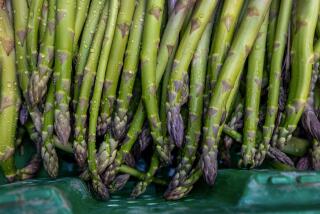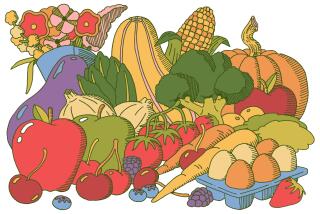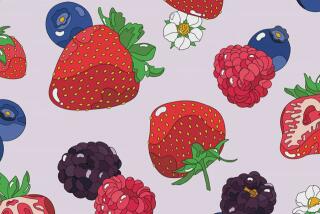Farmers Markets: Rhubarb worth stalking in early spring
Rhubarb is one of the great joys of spring, with its rosy color, earthy tang and old-fashioned allure, and the story of its local rise and fall is as intriguing as its flavor. Just a generation or two ago, it was widely cultivated in Southern California, but now local rhubarb is available almost exclusively at farmers markets, and just from a handful of vendors.
Rhubarb is native to central and northern Asia, where its roots were harvested for millenniums for their medicinal properties. In Britain, a mania for the edible stems began in the early 19th century, encouraged by the widespread availability of sugar and the discovery of techniques for forcing rapid stalk growth in dark hothouses, to produce an early harvest. Rhubarb’s great appeal was one of the few fresh fruits available in winter and spring.
In the United States, rhubarb was mostly grown in the Northern states, where it was naturally acclimatized. In New England around 1865, there was even a craze for wine made from rhubarb, which was promoted as the “great American wineplant,” but making rhubarb wine required lots of sugar, and the fad quickly fizzled.
In the 1890s, the renowned plant breeder Luther Burbank of Santa Rosa crossed established varieties with rhubarb from New Zealand or Australia and introduced new varieties, such as Crimson Winter, that were better adapted to winter and year-round cultivation in California’s mild climate. Immigrants from Northern states craved rhubarb, and plantings in California boomed. Farmers harvested rhubarb in winter and spring in coastal Southern California on close to 1,000 acres in the early 1920s; spring and summer was the season in the great rhubarb belt in San Leandro, in Alameda County. California’s rhubarb plantings reached 1,323 acres in the 1930 census.
Rhubarb production decreased during World War II because of shortages of sugar, fuel and labor but recovered somewhat in the 1950s.
Cleugh’s Rhubarb Co. of Buena Park was the nation’s largest grower, with 400 acres, in the early 1950s. Joel Cleugh, who was 92 when I interviewed him in 2004, said that he and his brother started growing rhubarb in 1932, first around Norwalk and Downey, and then in Los Alamitos, Chino, Rosemead and Bonsall. He produced the Cherry variety, with large, red stalks. The harvest ran from November to May, peaking in March and April. Much of the crop went to local buyers, including Knott’s Berry Farm, but he also shipped across the country.
In the 1960s, rhubarb consumption and production began a long decline. Frozen fruits offered consumers alternatives in winter and spring; imports of contra-seasonal fresh fruits increased greatly, and demand dwindled for fruits that required the inconvenience of cooking. Annual per capita consumption of rhubarb is now a pitiful 0.1 pound, down 88% from its heyday in the interwar years.
In California, where the demand for development and for strawberry cultivation pushed up the cost of suitable land, rhubarb farming almost disappeared. ABC Rhubarb, which started growing rhubarb in 1965 and farmed 80 acres in Compton, Paramount and South Gate in 1972, later switched to growing herbs and then gave up rhubarb completely about eight years ago. The last commercial rhubarb grower in California, Michael Horwath, sold his 60-acre planting in Valley Center in the early 1990s, when he got a lucrative offer for his land. As of the 2007 census, the latest count, only 4 acres of rhubarb remained in California. Domestic rhubarb production, which covers about 1,200 acres, is clustered in Washington, Oregon and Michigan.
It’s still possible, however, to find fresh rhubarb at Southern California farmers markets, from about half a dozen small-scale growers. Some harvest year-round, but the peak in quality and quantity is in early spring.
Laney Villalobos of Valley Center brings top-quality Cherry rhubarb to the downtown Santa Monica farmers market on Saturdays, from November to June. Trevino Farms of Lompoc offers an abundance of Strawberry rhubarb at the Santa Monica markets on Wednesdays downtown and in Virginia Park on Saturdays and at the Studio City market.
Stehly Farms of Valley Center sells rhubarb at the Torrance (Tuesday and Saturday), Irvine (Saturday) and Palos Verdes markets from February to August. Carol Thys of Fallbrook offers rhubarb every other week at the Torrance markets. Darold McCrary of Ventura has Victoria rhubarb, a speckled pink and green variety, crisp and tender, that originated around 1837; he’s at the Hollywood market year-round.
Patricia Davenport brings Crimson rhubarb from her Long Beach backyard to the Long Beach Southeast market, from February to April. Another home garden grower, Rose Wisuri, offers rhubarb from her seven plants at the Camarillo market.
Choose fresh stalks that are firm and crisp, not limp. There are some good varieties that are always green, but for a given variety, redder stalks are sweeter and richer. Size is no indication of tenderness.
To use rhubarb, cut off any remaining leaves, which contain toxic amounts of oxalic acid. The simplest preparation is to cut the stalks into 3/4-inch pieces, add a little water to a pot and stew over medium or low heat for about 10 minutes, until tender. Use more water for California rhubarb than for Northwestern stalks.
The question often arises whether rhubarb is a fruit or a vegetable, because it shares characteristics of both. Botanically it’s clearly not a fruit, defined as the flesh surrounding or adjacent to a plant’s seeds; the edible part of rhubarb, as for celery, is the petiole, the leafstalk. Horticulturally, in farm manuals and agricultural statistics, rhubarb is considered a vegetable.
But the U.S. Customs Court in Buffalo in 1947 classified rhubarb as a fruit (which at the time made it subject to lower import duties), since that is primarily how it is used. Its tart flavor is fruitlike, and one would most likely find it in the fruit section of a supermarket or cookbook. The Oxford English Dictionary definition of “fruit” concurs: “As denoting an article of food, the word is popularly extended to include certain vegetable products that resemble ‘fruits’ in their qualities, e.g. the stalks of rhubarb.”
More to Read
Eat your way across L.A.
Get our weekly Tasting Notes newsletter for reviews, news and more.
You may occasionally receive promotional content from the Los Angeles Times.










